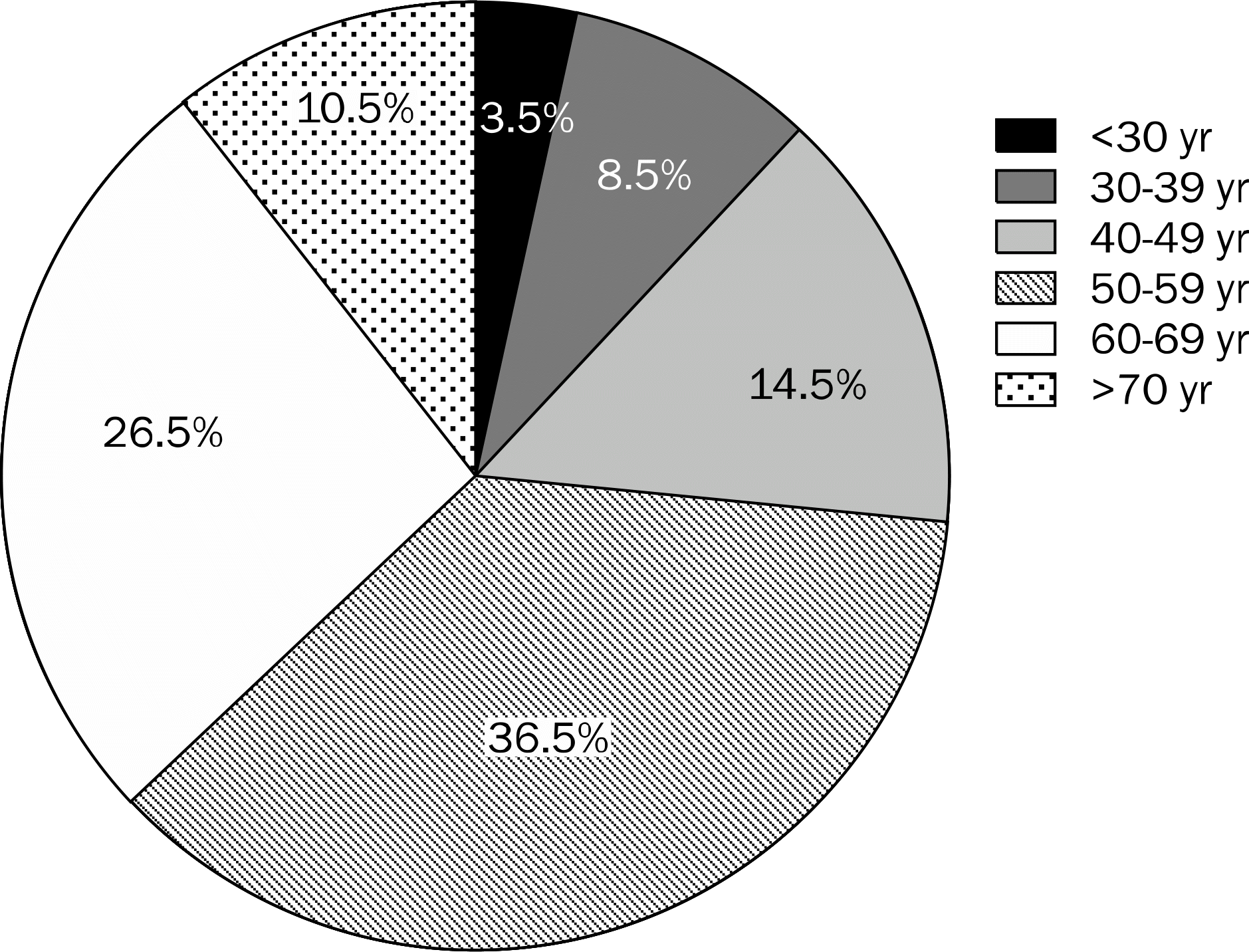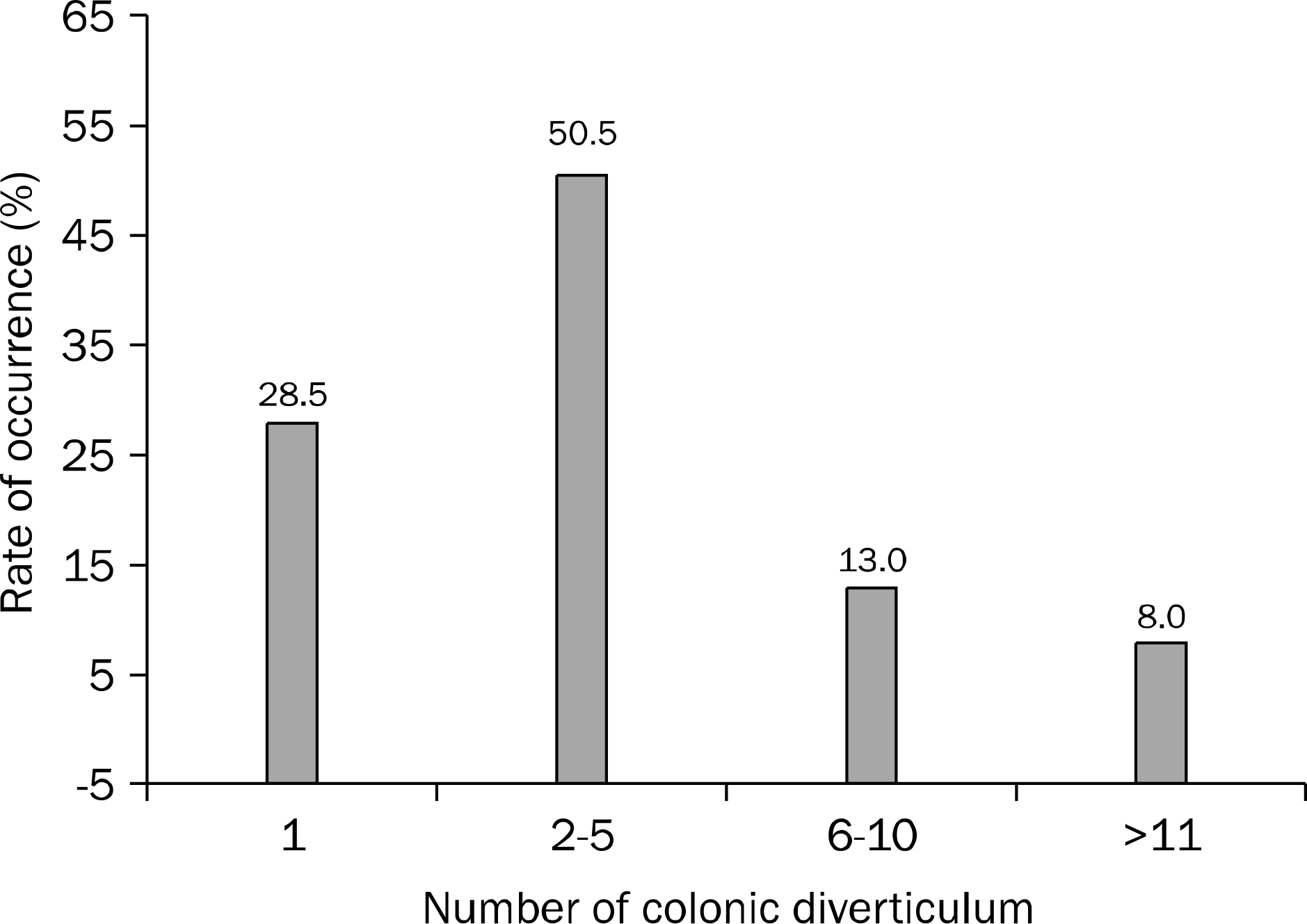Abstract
Background/Aims
The prevalence of colonic diverticulosis in Korea is increasing in conjunction with the adoption of western dietary pattern, extension of lifespan, and advances in diagnostic modalities. The clinical characteristics of colonic diverticulosis seem to be gradually becoming similar to those of Western societies. Therefore, factors associated with the clinical characteristics of colonic diverticulosis in Korea were investigated.
Methods
The data of 200 patients diagnosed with colonic diverticulosis using colonoscopy between May 2010 and April 2012 at Inje University Seoul Paik Hospital (Seoul, Korea) were prospectively collected. Clinical parameters acquired through a questionnaire include age, body mass index, waist circumference, exercise, diet, smoking, drinking habits, etc. Correlation between these factors and the clinical features of diverticulosis were analyzed.
Results
Mean age of the patients was 54.9±11.9 (range 17–79) years and male to female ratio was 2.2:1. Most diverticula were located on the right side of the colon (83%) and the mean number of diverticulum was 4.07±3.9. Factor associated with the location of diverticulum on the left side was age (p=0.001). There was a positive correlation between the waist circumference and the number of diverticulum (partial correlation coefficient r'=0.143, p=0.047). Diverticulitis occurred more frequently in younger patients than in older patients (p=0.002).
Go to : 
References
1. Parra-Blanco A. Colonic diverticular disease: pathophysiology and clinical picture. Digestion. 2006; 73(Suppl 1):47–57.

2. Martel J, Raskin JB. NDSG. History, incidence, and epidemiology of diverticulosis. J Clin Gastroenterol. 2008; 42:1125–1127.

3. Delvaux M. Diverticular disease of the colon in Europe: epidemiology, impact on citizen health and prevention. Aliment Pharmacol Ther. 2003; 18(Suppl 3):71–74.

4. Jun S, Stollman N. Epidemiology of diverticular disease. Best Pract Res Clin Gastroenterol. 2002; 16:529–542.

5. Kim HU, Kim YH, Choe WH, et al. Clinical characteristics of colonic diverticulitis in Koreans. Korean J Gastroenterol. 2003; 42:363–368.
6. Choi CS, Cho EY, Kweon JH, et al. The prevalence and clinical features of colonic diverticulosis diagnosed with colonscopy. Korean J Gastrointest Endosc. 2007; 35:146–151.
7. Petruzziello L, Iacopini F, Bulajic M, Shah S, Costamagna G. Review article: uncomplicated diverticular disease of the colon. Aliment Pharmacol Ther. 2006; 23:1379–1391.

8. Nakaji S, Danjo K, Munakata A, et al. Comparison of etiology of right-sided diverticula in Japan with that of left-sided diverticula in the West. Int J Colorectal Dis. 2002; 17:365–373.

9. Song JH, Huh JG, Kim YS, et al. Clinical characteristics of colonic diverticular disease diagnosed with colonoscopy. Intest Res. 2008; 6:110–115.
10. Song JH, Kim YS, Lee JH, et al. Clinical characteristics of colonic diverticulosis in Korea: a prospective study. Korean J Intern Med. 2010; 25:140–146.

11. Strate LL, Liu YL, Aldoori WH, Syngal S, Giovannucci EL. Obesity increases the risks of diverticulitis and diverticular bleeding. Gastroenterology. 2009; 136:115–122.

12. Tan KY, Seow-Choen F. Fiber and colorectal diseases: separating fact from fiction. World J Gastroenterol. 2007; 13:4161–4167.

13. Place RJ, Simmang CL. Diverticular disease. Best Pract Res Clin Gastroenterol. 2002; 16:135–148.

14. Kim WY, Cho MS, Lee HS. Development and validation of mini dietary assessment index for Koreans. Korean J Nutr. 2003; 36:83–92.
15. Choi SH, Kim DJ, Lee KE, et al. Cut-off value of waist circumference for metabolic syndrome patients in Korean adult population. J Korean Soc Study Obes. 2004; 13:53–60.
16. Kim KH, Kim YB, Kang JK, Kim SJ. A clinical study of diverticulosis of the colon. J Korean Med Assoc. 1986; 29:63–68.
17. Kim KS. Recent changes of colonic diverticulosis in Korea. J Korea Radiol Soc. 1984; 20:632–638.

18. Ko JK, Lee JK, Yun EJ, Moon HJ, Shin HJ. Colonic diverticulosis: evaluation wth double contrast barium enema. J Korean Radiol Soc. 1997; 36:285–289.

19. Kim JS, Cha SG, Kim YT, et al. The prevalence and clinical features of diverticular disease of the colon. Korean J Gastroenterol. 1993; 25:305–314.
20. Jacobs DO. Clinical practice. Diverticulitis. N Engl J Med. 2007; 357:2057–2066.
21. Gear JS, Ware A, Fursdon P, et al. Symptomless diverticular disease and intake of dietary fibre. Lancet. 1979; 1:511–514.

22. Aldoori WH, Giovannucci EL, Rimm EB, Wing AL, Trichopoulos DV, Willett WC. A prospective study of diet and the risk of symptomatic diverticular disease in men. Am J Clin Nutr. 1994; 60:757–764.

23. Law WL, Lo CY, Chu KW. Emergency surgery for colonic diverticulitis: differences between right-sided and left-sided lesions. Int J Colorectal Dis. 2001; 16:280–284.

24. Lim JS, Sohn CY, Bae OS, Park SD. A retrospective study comparing clinical characteristics between the right and left colonic diverticular disease. J Korean Soc Coloproctol. 1999; 15:219–226.
25. Kim JI, Yu BC, Jeon MJ, et al. Correlation of metabolic syndrome with waist circumference and waist-to-height ratio. Korean J Obes. 2009; 18:87–93.
26. Hwang KY, Yang HW, Kim SH, et al. Clinical characteristics of colonic diverticulitis in young patients. Korean J Med. 2008; 74:250–257.
Go to : 
 | Fig. 1.Age distribution of the patients with colonic diverticulosis. The percentage of patients with colonic diverticulosis increases with advancing age and peaks in the 50–59 year age group. |
 | Fig. 2.Number of colonic diverticulum. The most common number of colonic diverticulum ranges from 2 to 5. |
Table 1.
Scores on Corrected Mini Dietary Assessment Index
Table 2.
Univariate Analysis of the Variables Associated with the Location of Colonic Diverticulum
Table 3.
Multivariate Analysis of the Variables That Associated with Left Side Location of Colonic Diverticulum by Logistic Regression Analysis
Table 4.
Univariate Analysis after Adjustment for Other Variables That Can Be Associated with Number of Colonic Diverticulum
Table 5.
Multivariate Analysis of the Variables That Associated with Colonic Diverticulitis by Logistic Regression Analysis




 PDF
PDF ePub
ePub Citation
Citation Print
Print


 XML Download
XML Download